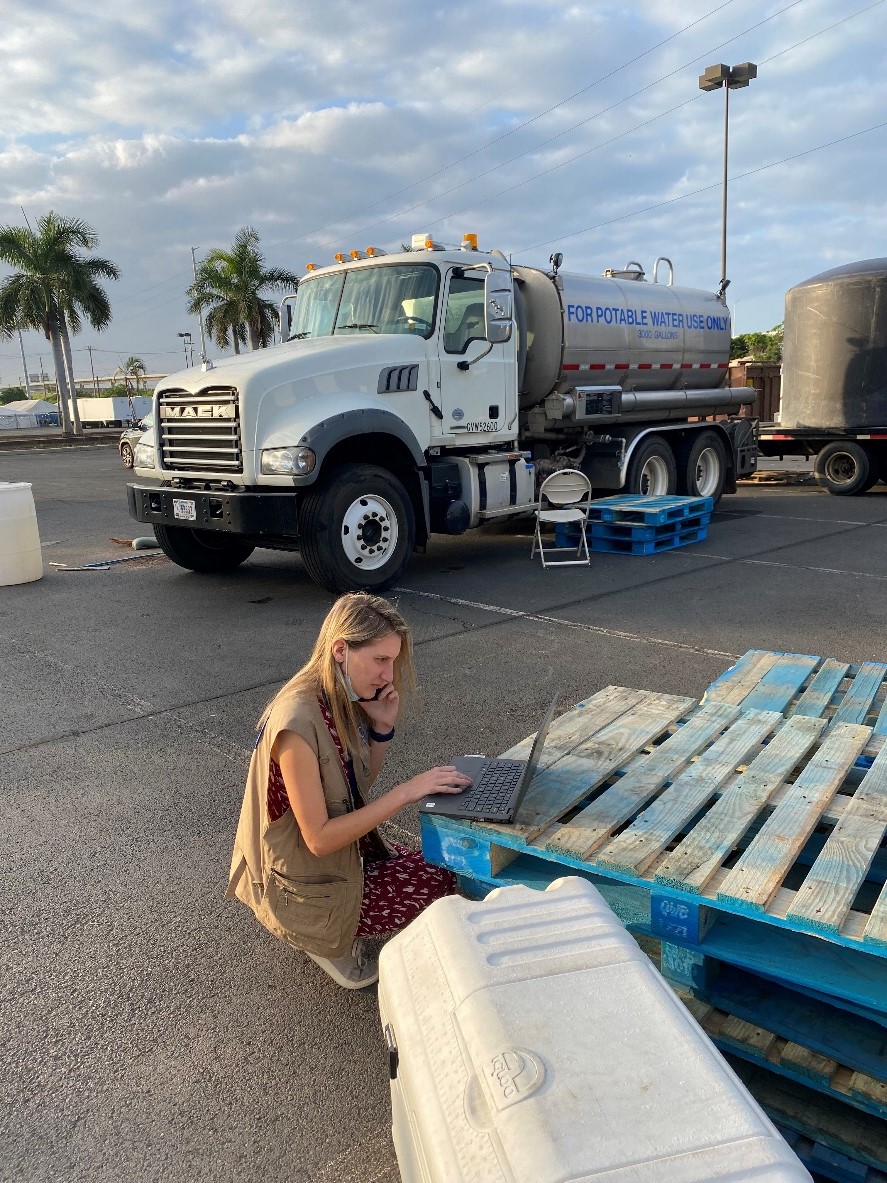Red Hill Response: First ACE Investigation
Red Hill Response — First ACE Investigation
At the request of the Hawaii Department of Health (HDOH), the first ACE investigation collected survey information from civilians, military personnel, and the families who worked or lived in areas served by the Joint Base Pearl Harbor-Hickam Water Distribution System and were affected by the November 20, 2021, water contamination. The survey asked participants how they were exposed to the contaminated water, health symptoms they experienced, medical care they sought, and impacts to their children and pets.

An ACE investigation team member enters survey data at a water distribution site. Image source: Photo taken by ATSDR. All people in photo are CDC/ATSDR staff.
The ACE investigation promoted the survey through electronic and in-person outreach. This facilitated rapid information collection from affected people across a wide geographic area, including many who were displaced from their homes.
For the ACE conducted from January-February 2022, the team assisted HDOH by
- designing a questionnaire for data collection,
- modifying the survey so participants could take it online,
- developing a data management plan,
- collecting data through in-person interviews and electronic self-administered surveys,
- analyzing survey results, and
- providing public health recommendations based on the ACE’s results.
Key Findings
2,289 eligible participants submitted surveys. At least one household member participated from 1,389 (14%) of 9,694 estimated affected households.
Nearly 90% of survey participants reported at least one new or worsening symptom since the incident. 17 participants reported being hospitalized overnight. Many reported symptoms were consistent with previous studies of exposure to petroleum hydrocarbons, such as those related to the respiratory system, gastrointestinal tract, nervous system, and mental health. Some participants reported experiencing some symptom relief after switching to an alternative water source. This also supports the association between symptoms and the contaminated water.
Exposure Routes
An exposure route is the way a chemical enters a person or animal’s body.
- 1,115 participants (52%) reported at least one indication that their water was contaminated (petroleum smell or taste, or visible oily sheen).
- 1,821 participants (80%) reported that they ingested the potentially contaminated water through oral hygiene.
- 1,650 participants (72%) reported that they ingested the potentially contaminated water through drinking.
- 1,629 participants (71%) reported that they ingested the potentially contaminated water through cooking.
Health Symptoms
- 1,980 participants (87%) self-reported one or more new or worsening health symptom after the incident.
- 1,493 participants (75%) reported symptoms lasting for 30 or more days.
- The largest percentage of reported symptoms were related to the nervous system (62%); followed by the gastrointestinal system (58%); skin (58%); the ears, nose, or throat (47%); mental health (46%); the eyes (42%); and the respiratory system (31%).
- 853 participants (37%) sought medical care after the incident; 17 participants reported being hospitalized overnight.
- 2,123 participants (93%) switched to an alternative water source after learning of the incident.
- 1,591 of the 1,980 symptomatic participants (80%) reported an improvement in their symptoms after switching to an alternative water source.
Recommendations
Based on the ACE investigation’s findings, the ACE team made recommendations to HDOH:
- Rebuild communities’ confidence in the drinking water system by strengthening communication across agencies and with the public.
- Provide support to clinical providers to help them better identify, assess, treat, and document affected individuals, including identifying and mitigating psychosocial stressors.
- Ensure equity in the response across the affected populations.
- Consider additional health investigations, including a 6-month follow-up ACE investigation and activities to better understand longer-term health risks.